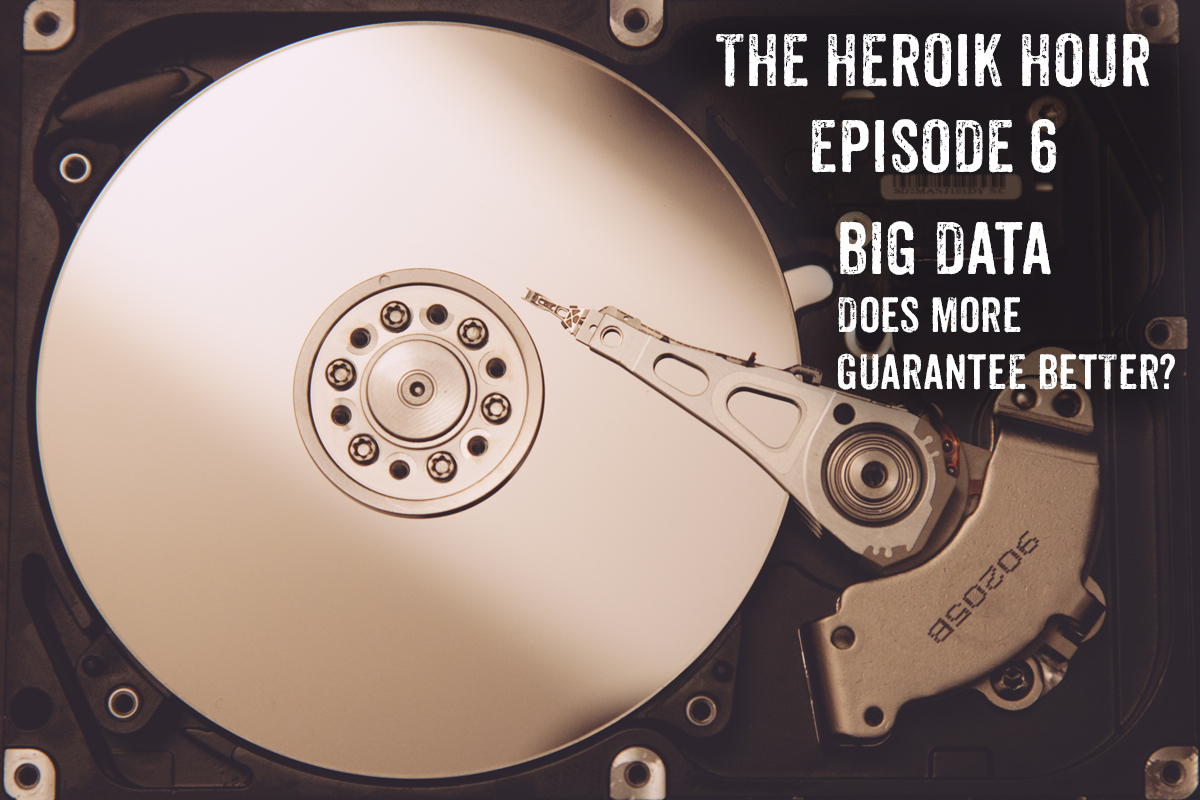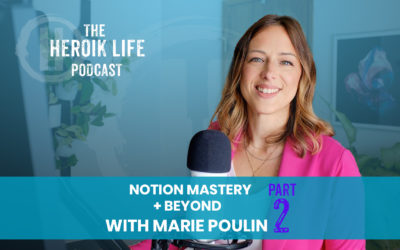When you think of big data, you think of big business right? Well you shouldn’t. Every business should and probably is taking advantage of the heaps of data flowing out there. Here are but a few examples:
-Google analytics
-Facebook Marketing Tools
-Google Insights
-Experian /Gallup / Forrester Research
All of these offer big data solutions. And whether you’re riding the coattails by reading their articles, or using their products directly, big data is part of the Heroik day to day.
Now, there comes a point when it’s worth asking, does more guarantee better? How’s that ROI on Big Data going? We’re going to cover that today in this episode of the Heroik Hour. Let’s get started.
[INTRO MUSIC]
Welcome to the Heroik Hour, I’m your host Nicholas McGill, Chief Experience Officer for Heroik Media. And on this podcast, I give you a little technology, leadership and culture, or Heroik TLC as we like to say. In this episode, we’re going to open the can of worms and take our first swipe at big data.
First, what is big data anyway?
There’s all these new sources of data, thanks to all the smart devices that record measurements, movements and certain behaviors. And there’s way too much for 1 person to make sense of on their own. But, thanks to a little computing horsepower, these analytic tools can help take these huge data sets and reveal potential patterns, trends, and associations, especially relating to human behavior and interactions. The insights gained from all this data can help people and businesses learn, grow, and advance, form more effective strategies in many different areas from medicine to marketing.
There’s a growing narrative out there that says, if we’re able to all this with this data, why not throw more fuel on the fire? Does more guarantee better? Does more data, more raw firehose data equal good, does it give a competitive advantage.
Big data as a term gets tossed around like a magic spell for business. The reality is it’s not a cosmic force that controls the universe and despite the incredible things these new data tools can do, they’re not perfect and they come with new challenges for business.
Unless, you can quickly filter it down into actionable intelligence that leads to positive gains the answer is a resounding NO. Of course not. Are you able to effectively and efficiently leverage your current data and analytics tools. Or are you overwhelmed? If you can’t effectively leverage the information into actionable intelligence, simply consuming more isn’t going to help you. But more, is exactly what’s being sold and recommended as a best practice.
Let’s dive into this a bit.
Who benefits from selling you more vs. better to begin with?
If you’re struggling with calculating ROI on your big data initiatives – you’re not alone. Many are reluctant to ask their peers about it, others don’t talk about it, but the elephant in the room needs to come atop the agenda, as does the culture that finds it appropriate not to discuss it.
It’s a hot business buzz word after all.
No one wants to appear out of touch with best practices… but how do we know they are best practices? Who decides that? The people selling you the story that more is better, are the same you sell you the big data services or benefit from it.
The leading providers of big data, analytics, and business information including management review, literature and insights from research firms, has always trended in vague support of anything new until the real data and evidence to the contrary is overwhelming.
So you can’t trust the business magazines, who now more than ever operate like gossip columns and pander for attention. The major research firms also sell the data, so their information too falls suspect.
Why is the ROI of Big Data initiatives such a difficult question to answer?
Well, it’s a big topic that affects the entire organization and just about every department. BIG Data isn’t one thing. It’s a whole lot of things.
- What market research tools should sales and marketing teams use?
- What top sheet analyses and dashboards should leadership look at?
- Which providers have business models positioned and dependent upon providing only the most relevant, actionable information? (HINT VERY FEW IF ANY).
- What are the most relevant signals to pay attention to?
- How are data sources prioritized?
These are but a few questions in the grand scheme of big data. And the reason that ROI is continuing to be elusive in these conversations, is that answering the question is being delegated to the middle of the organization, since it is not clearly understood at the top and by most advisors.
However, for advisors who are on the front lines getting their hands dirty, the multidisciplinary, cross-functional, thinker-builders, it’s easy to identify opportunities to leverage and refine efforts and specific strategies for various departments, industries, and sources.
What additional motives do thought leaders, advisors and managers have that might keep them silent on the ROI on big data question?
Many leaders, managers and advisors may have tied their careers onto big data initiatives, and bet the farm that it will pay out. And when the room goes silent on the ROI question, just as it has jumping into the details for other vague business buzzwords like social media, holacracy structures, and others, then you know you have a potential problem.
Second, advisors can describe the wave, what it looks like and it’s potential and that’s about it. Many of them have proudly championed these topics at 20,000 feet, and haven’t a clue how to put it to practice or integrate it and align it with the important parts of the organization. Many advisors want to ride the hype wave of big data don’t know how to surf.
Third, there is a tactical advantage to keeping the concept of Big Data murky, vague and untenable. It becomes a useful tool for obfuscation. Many professionals knowingly, or unknowingly directly leverage complex ill defined concepts to insulate their business model or department.
Here are two examples:
- VP’s, Product Managers, Sales managers, Marketing managers hide in metrics, charts and analyses to bury truth in complexity all the time. This isn’t bad practice of them though – it’s symptomatic of a disingenuous culture, industry, and work environment that would blame, punish and fire them for sounding alarm. This is what happens when employees don’t trust that you’d have their backs for being honest (even though the organization claims to value integrity). Obfuscation ensures they live to fight another day.
- Advisors, Consultants, SaaS providers, rely on on big data tools and their partners to validate and augment their value propositions, and rationalize larger, and more fee$ (Yes, I said it). Analytics, metrics, and research models have been doing this for years dumping bad data in with the good to upcycle it and bundle it into more expensive market research products. This creates hefty price tags and crappy products.
Fourth, and this is crazy but common, many companies are sold on the idea that the answer to their big data dilemma is more data. The strategy being, if you buy by the barrel, instead of the gallon, you’ll have more insights than anybody else. One need only look at the vague “insights” of the major business research firms to see that isn’t true. Usually these efforts result in more vague correlations or obvious observations like “the sky is blue”. Bigger data doesn’t ALWAYS mean better data.
Great example – Let’s crowd source and split test it!
Before we were using the phrase big data, the wisdom of the crowds was all the rage. The concept/definition seem to water-down to equal wisdom of the masses,v s. a targeted, collective intelligence. It is a form of big data. And, the wisdom of the crowds is limited. People fling this concept around as if it has no downside. You get populism and popular stupidity alongside popular wisdom. This is how you make idiots popular and dumb ideas that waste insane amounts of money. More opinions, more voices, more inputs, does not nor will it ever Guarantee better. People who believe this assume the crowd is intelligent, unselfish, and well informed, and perfectly motivated. These faulty assumptions are exactly what gave rise to behavioral economics as a field of study.
A majority of people are not super discerning nor value the things your target market are focused on. So be careful with this form of big data.
An example of the hilarity and weakness of the wisdom of crowds.
Remember the movie the Three Amigos when Lucky, played by Chevy Chase, is disguised as a Mexican bandit, and says “We’ll rape the horses and ride off on the women!” Imagine you have a crowd that’s 51% male and 49% female, you can get bad decisions by going with strict populism or wisdom of the crowds really quick. And once you filter out stupidity, non-sense, and actions out of alignment with the culture and brand of the organization, you’re down to what, the wisdom of the masses? Or a small targeted crowd that aligns with your lens in the first place that validates what you already know. Bottom line – wisdom of the crowds isn’t a solve all or a replacement for critical thinking.
How do you make an organization data smart?
An efficient way to address big data company wide, and not create big-data drags or get lost on buzz-word initiatives, is to make the organization as a whole more resilient to bullshit in the first place.
Use the soft infrastructure of the organization, the brand and culture. Establish a cultural posture of discernment. Equip the entire organization with the right and the duty to be skeptical, curious, to trust but verify.
- Back model not only the data /analysis tools to see if it’s providing signal or noise and to what degree.
- Consider the motivations, metrics and benefits to the source to have you thinking in terms of how they frame the data to begin with.
- Consider the data consumption habit. Is the organization mindful of the data it swallows, or does it eat everything on the table?
This strategy has implications that tie into and align with training initiatives with leaders and teams to ensure they have rock solid, shockproof shit detectors (as Ernest Hemingway would put it), know how to understand, weed out statistical fallacies, fallacious conclusions and quickly filter out and reject nonsense from the get-go. Such an investment is smaller in comparison to the countless billions of dollars wasted on big data more is better strategies, and all of the resources that must be dedicated to processing it and creating actionable intelligence with it. Equip your organization with a culture of discernment! This ensures not only that your organization is resilient to the noise, but that it only buys or invests in lean and clean data tools from the outset.





0 Comments